AP Bio Unit 3.1-3.3
1/100
There's no tags or description
Looks like no tags are added yet.
Name | Mastery | Learn | Test | Matching | Spaced |
|---|
No study sessions yet.
101 Terms
Metabolism
The totality of an organism's chemical reactions, consisting of thousands of reactions organized into intersecting metabolic pathways that manage the material and energy resources of the cell.
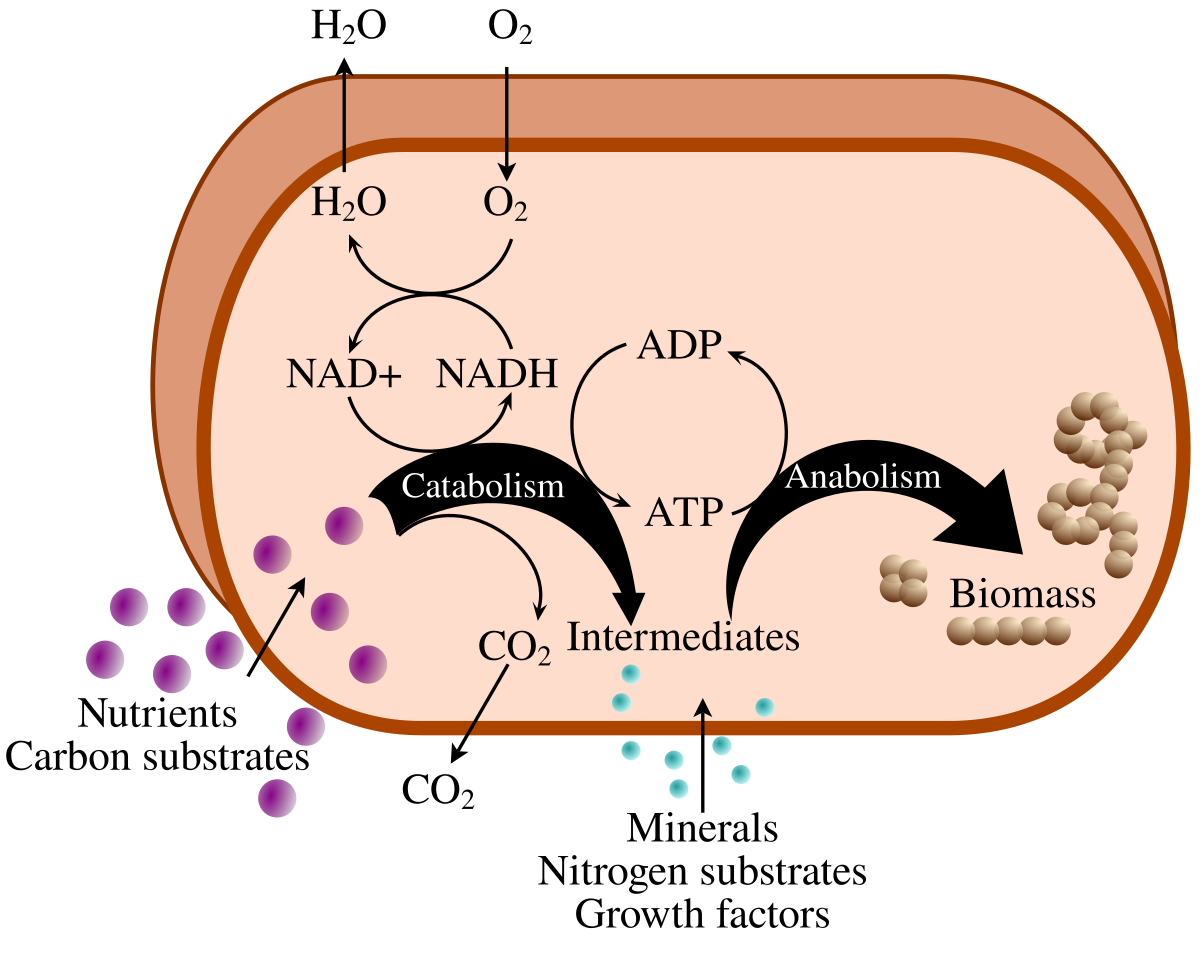
Metabolic Pathway
A series of defined steps, each catalyzed by a specific enzyme, that begins with a specific molecule and results in a certain product.

Catabolic Pathway (Catabolism)
A metabolic pathway that releases energy by breaking down complex molecules into simpler compounds (e.g., cellular respiration breaks down glucose into CO2 and H2O).

Anabolic Pathway (Anabolism)
A metabolic pathway that consumes energy to build complex molecules from simpler ones (e.g., protein synthesis joins amino acids into a polypeptide).

Kinetic Energy
The energy associated with the relative motion of objects. Includes thermal energy (heat from random molecular motion) and light energy (photons).
Potential Energy
The energy that matter possesses because of its location or structure. Includes chemical energy stored in molecular bonds (e.g., in glucose, ATP).
Thermodynamics
The study of energy transformations that occur in a collection of matter.
First Law of Thermodynamics
The principle of conservation of energy: Energy can be transferred and transformed, but it cannot be created or destroyed.

Second Law of Thermodynamics
Every energy transfer or transformation increases the entropy (disorder) of the universe. During these transfers, some energy is lost as heat.
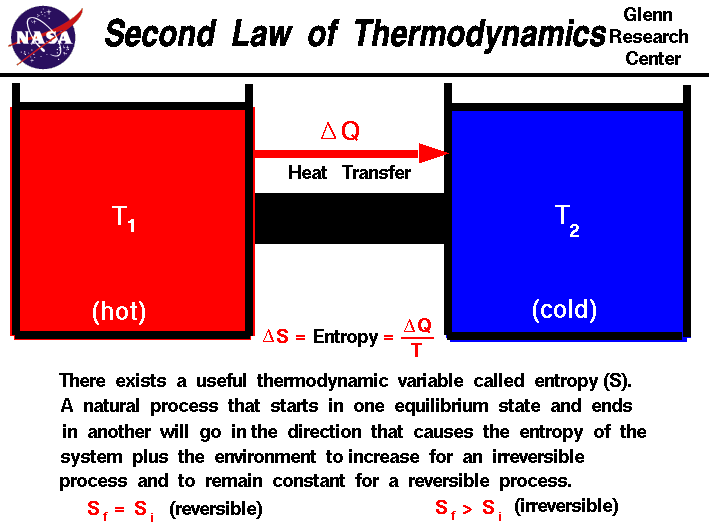
Entropy
A measure of molecular disorder or randomness; the amount of energy in a system that is unavailable to do work.
Free Energy (G)
The portion of a system's energy that can perform work when temperature and pressure are uniform throughout the system. It measures a system's instability and tendency to change.
Change in Free Energy (ΔG)
The difference in free energy between the final and initial state of a system (ΔG = Gfinal - Ginitial). It predicts whether a process is spontaneous.
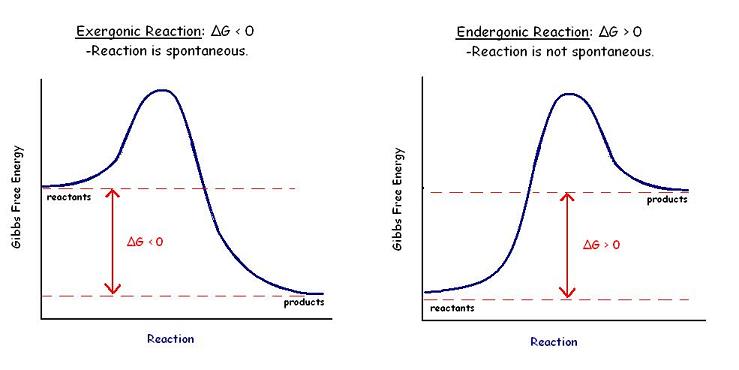
Spontaneous Process
A process that can occur without an input of energy; it has a negative ΔG (exergonic), increases the stability of the system, and increases the entropy of the universe.
Exergonic Reaction
A reaction that proceeds with a net release of free energy (ΔG is negative); it is spontaneous (e.g., cellular respiration, ATP hydrolysis).
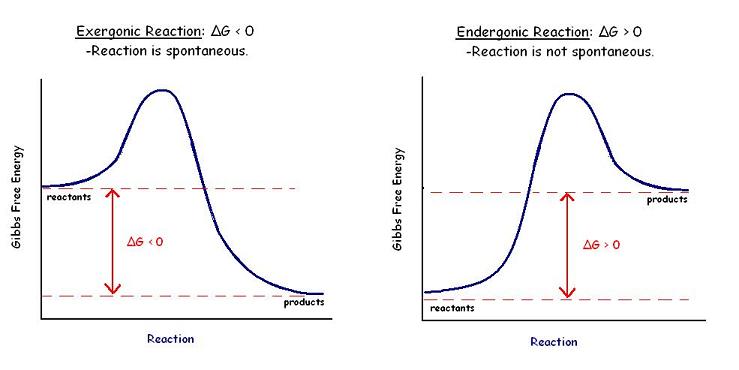
Endergonic Reaction
A reaction that absorbs free energy from its surroundings (ΔG is positive); it is non-spontaneous and requires an input of energy (e.g., photosynthesis, ATP synthesis).
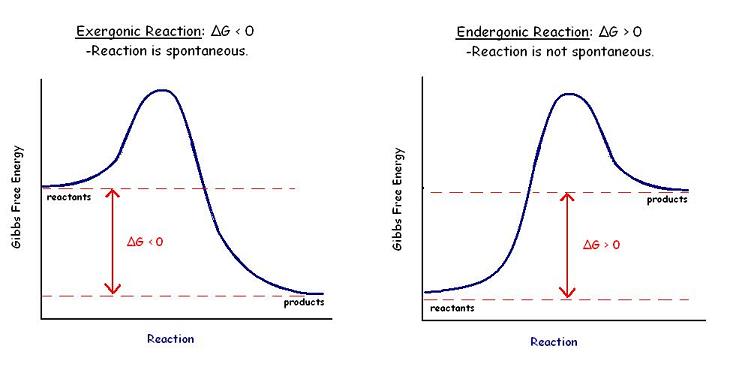
Activation Energy (Ea)
The initial investment of energy required to start a chemical reaction; the energy required to contort the reactant molecules so bonds can break.
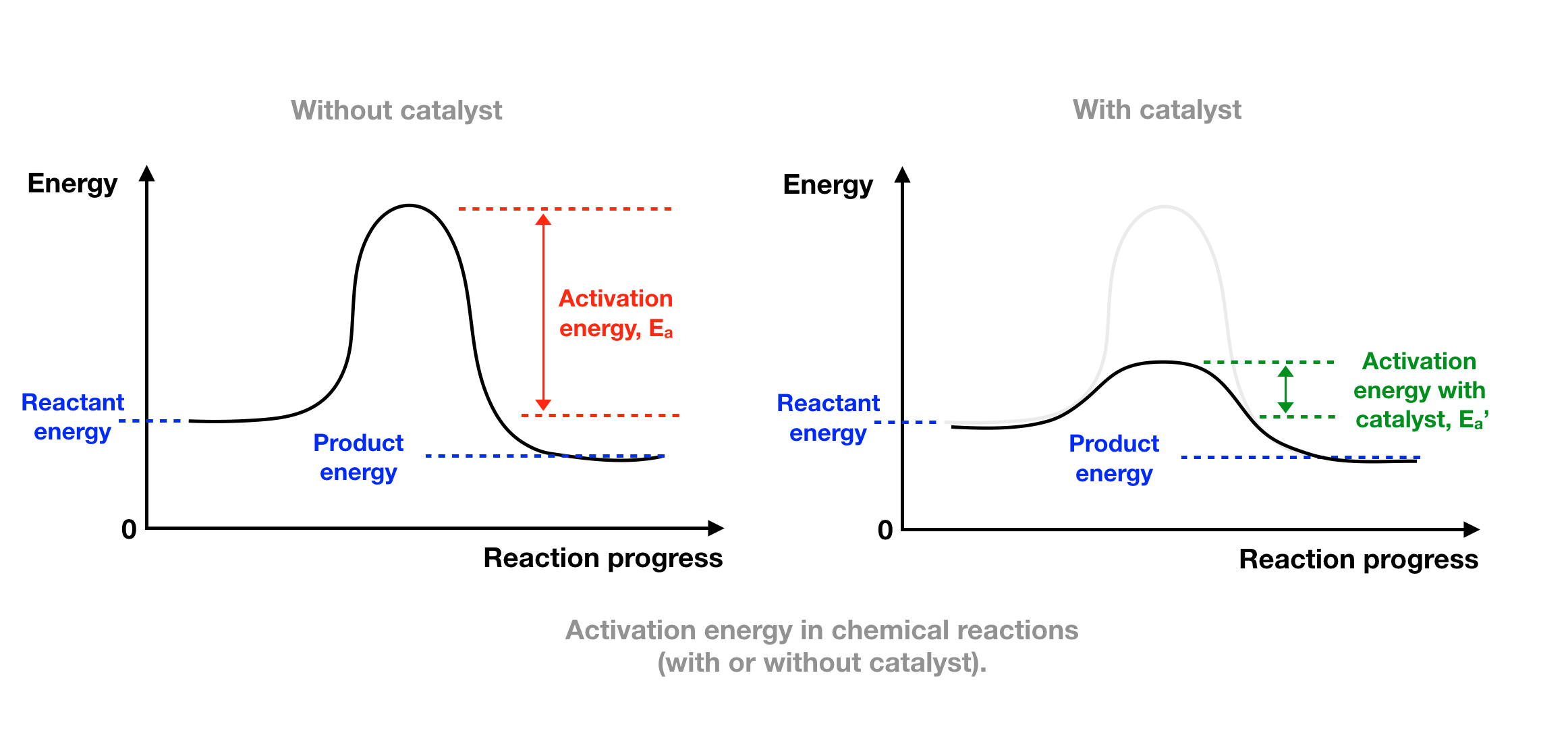
Enzyme
A macromolecule (usually a protein) that acts as a biological catalyst, speeding up a reaction by lowering the activation energy barrier without being consumed.
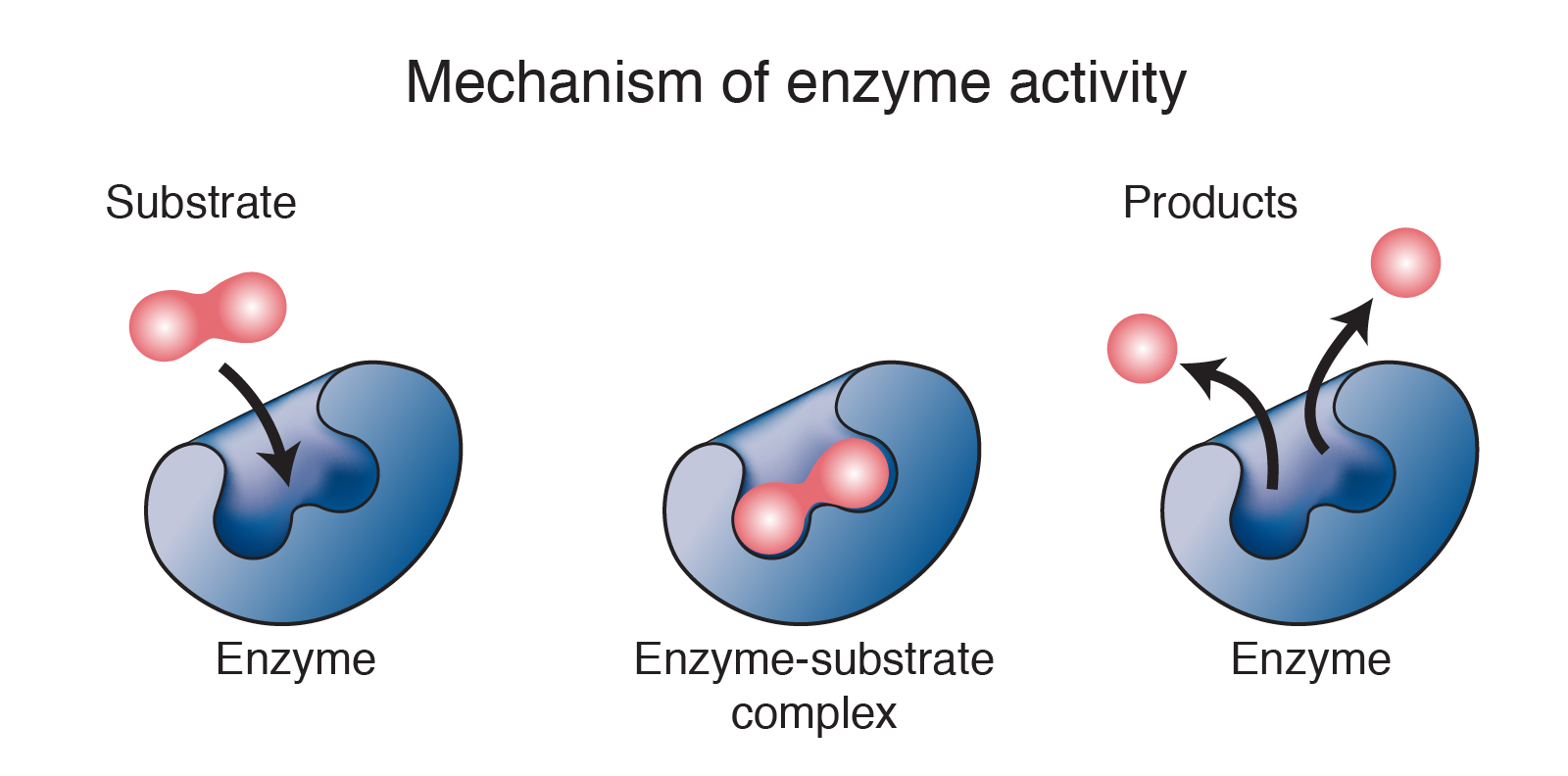
Catalyst
A chemical agent that speeds up a reaction without being consumed by the reaction.
ATP (Adenosine Triphosphate)
The cell's energy shuttle; composed of adenine, ribose, and three phosphate groups. Hydrolysis of ATP is exergonic (ΔG = -7.3 kcal/mol).
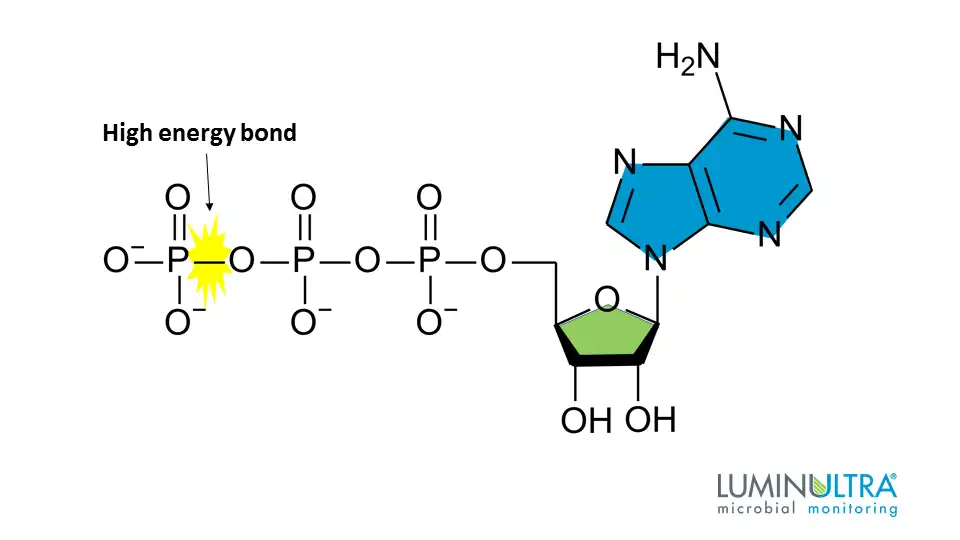
ATP Hydrolysis
The exergonic reaction where ATP is broken down to ADP and an inorganic phosphate (Pi), releasing energy that can be used to drive endergonic reactions in the cell.
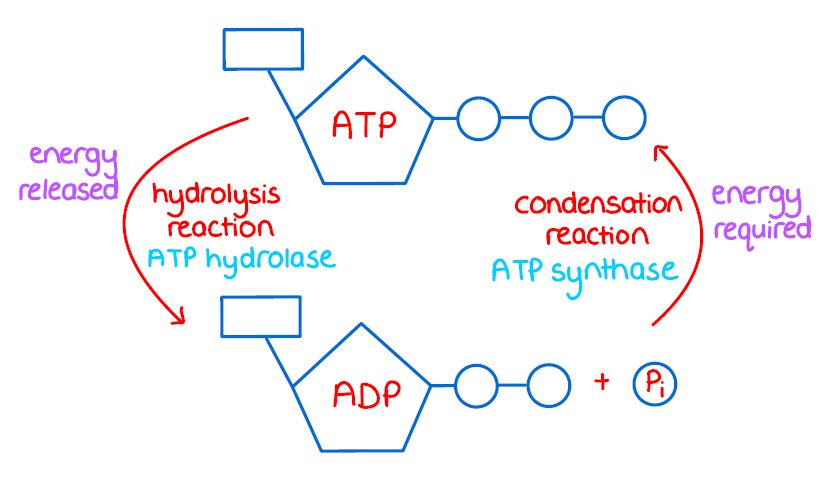
Phosphorylation
The transfer of a phosphate group, usually from ATP, to another molecule. This is a common mechanism for activating a substrate or performing cellular work.
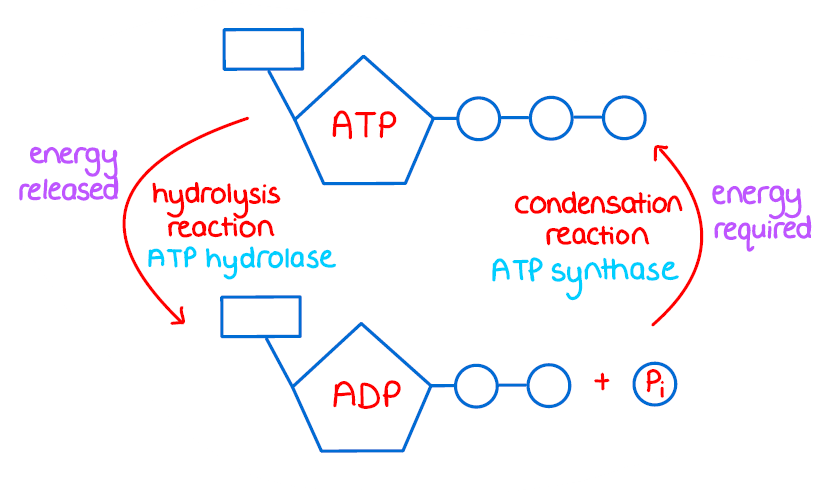
ATP Coupling
The use of energy released from an exergonic reaction (like ATP hydrolysis) to drive an essential endergonic reaction, resulting in an overall exergonic process.
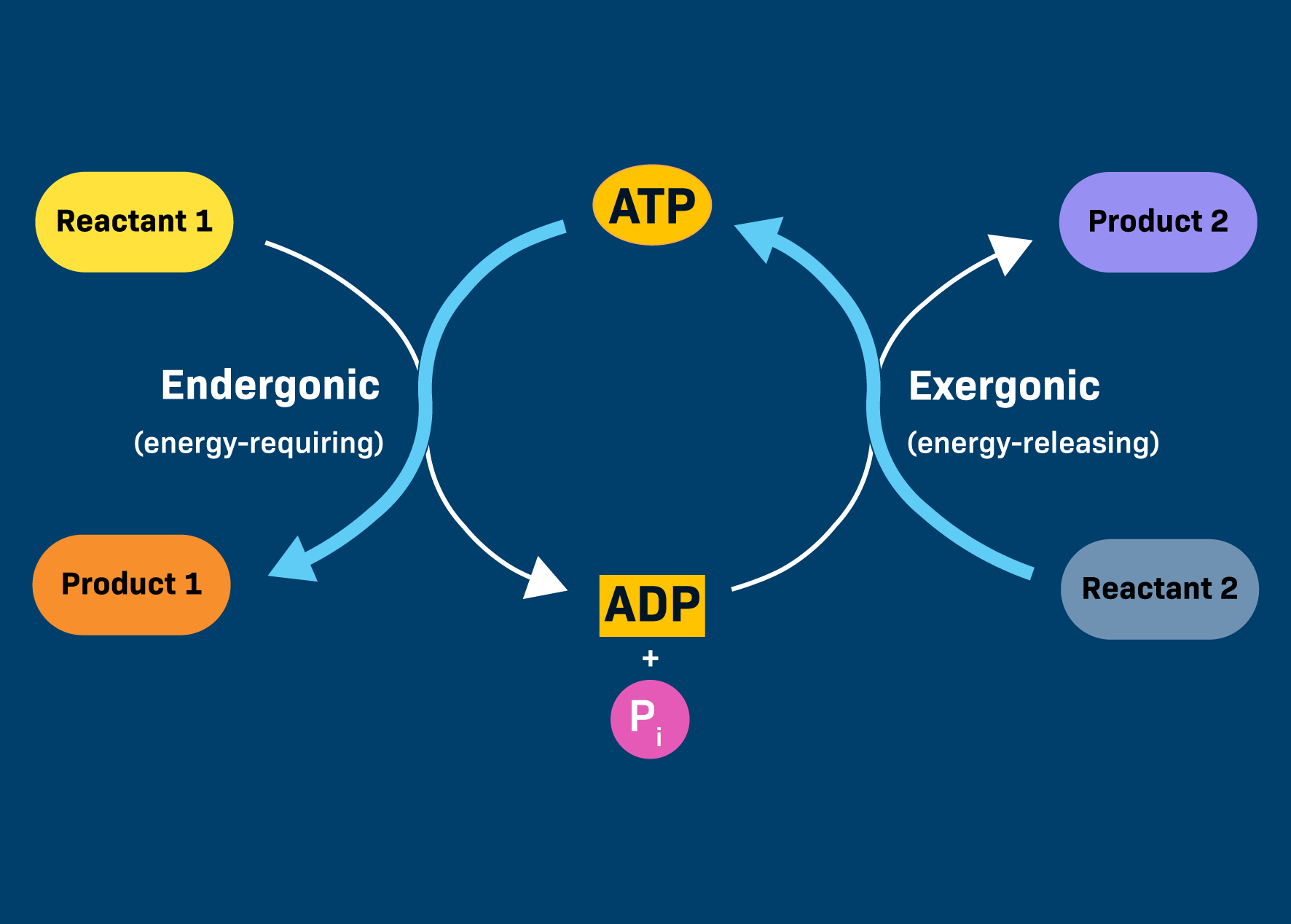
Chemical Work
The pushing of endergonic reactions that would not occur spontaneously, such as the synthesis of polymers from monomers.
Transport Work
The pumping of substances across membranes against their concentration gradient (active transport).
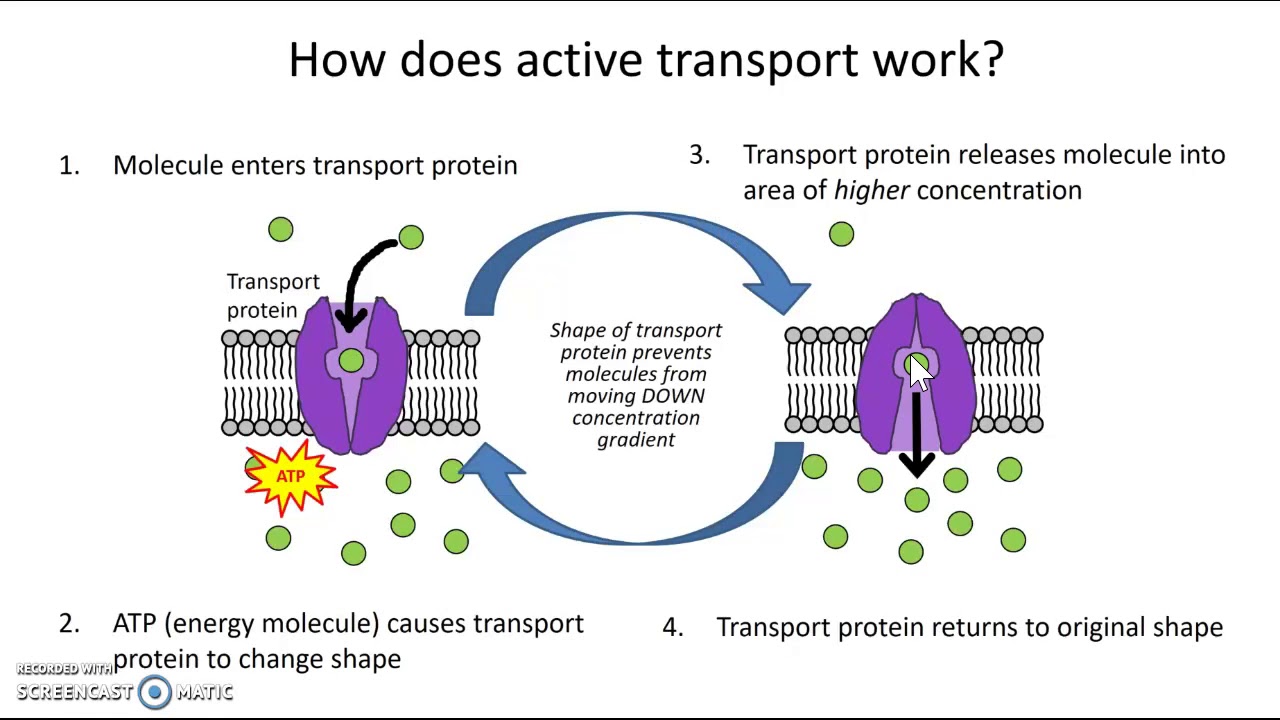
Mechanical Work
The beating of cilia, contraction of muscle cells, and movement of chromosomes during cellular reproduction.
Redox Reaction (Oxidation-Reduction)
A chemical reaction involving the complete or partial transfer of one or more electrons from one reactant to another.
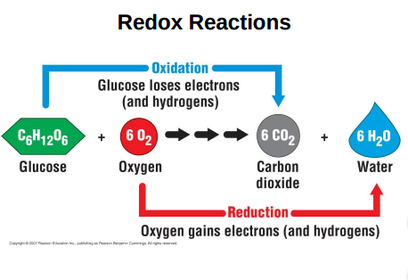
Oxidation
The loss of electrons from a substance involved in a redox reaction. Often involves the loss of hydrogen atoms or gain of oxygen atoms.
Reduction
The addition of electrons to a substance involved in a redox reaction. Often involves the gain of hydrogen atoms or loss of oxygen atoms.
Reducing Agent
The electron donor in a redox reaction; it becomes oxidized.
Oxidizing Agent
The electron acceptor in a redox reaction; it becomes reduced.
NAD+ (Nicotinamide Adenine Dinucleotide)
A coenzyme that cycles between NAD+ (oxidized) and NADH (reduced) and acts as an electron carrier, primarily in cellular respiration.
FAD (Flavin Adenine Dinucleotide)
A coenzyme that cycles between FAD (oxidized) and FADH2 (reduced) and acts as an electron carrier, primarily in the Krebs cycle.
Electron Carrier Molecule
A molecule that accepts high-energy electrons during redox reactions and carries them to an electron transport chain (e.g., NADH, FADH2, NADPH).
Cellular Respiration
The catabolic pathway where organic molecules (like glucose) are broken down using oxygen (aerobic) or other electron acceptors (anaerobic) to produce ATP.
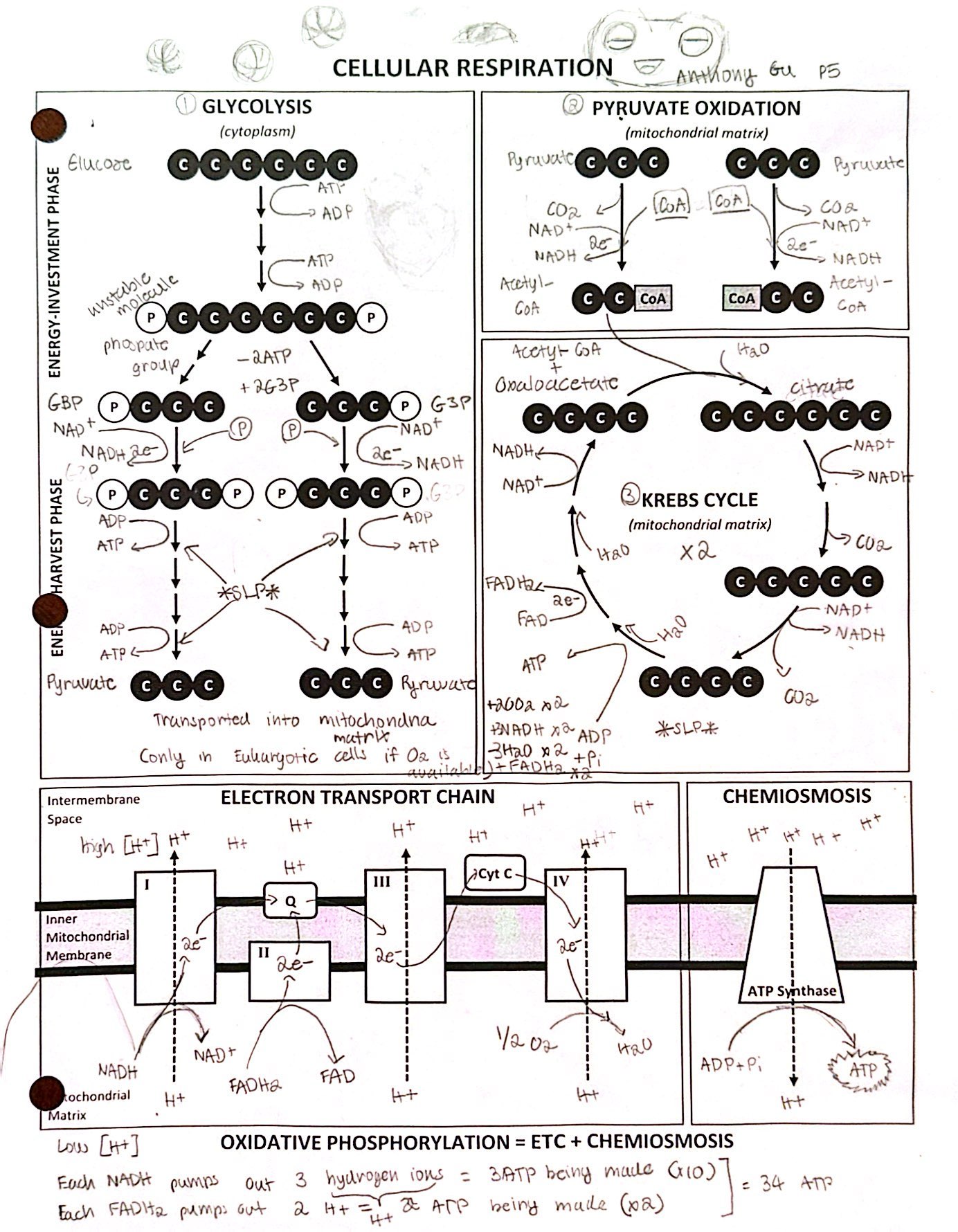
Aerobic Respiration
A type of cellular respiration that requires oxygen as the final electron acceptor; includes glycolysis, pyruvate oxidation, the Krebs cycle, and oxidative phosphorylation.
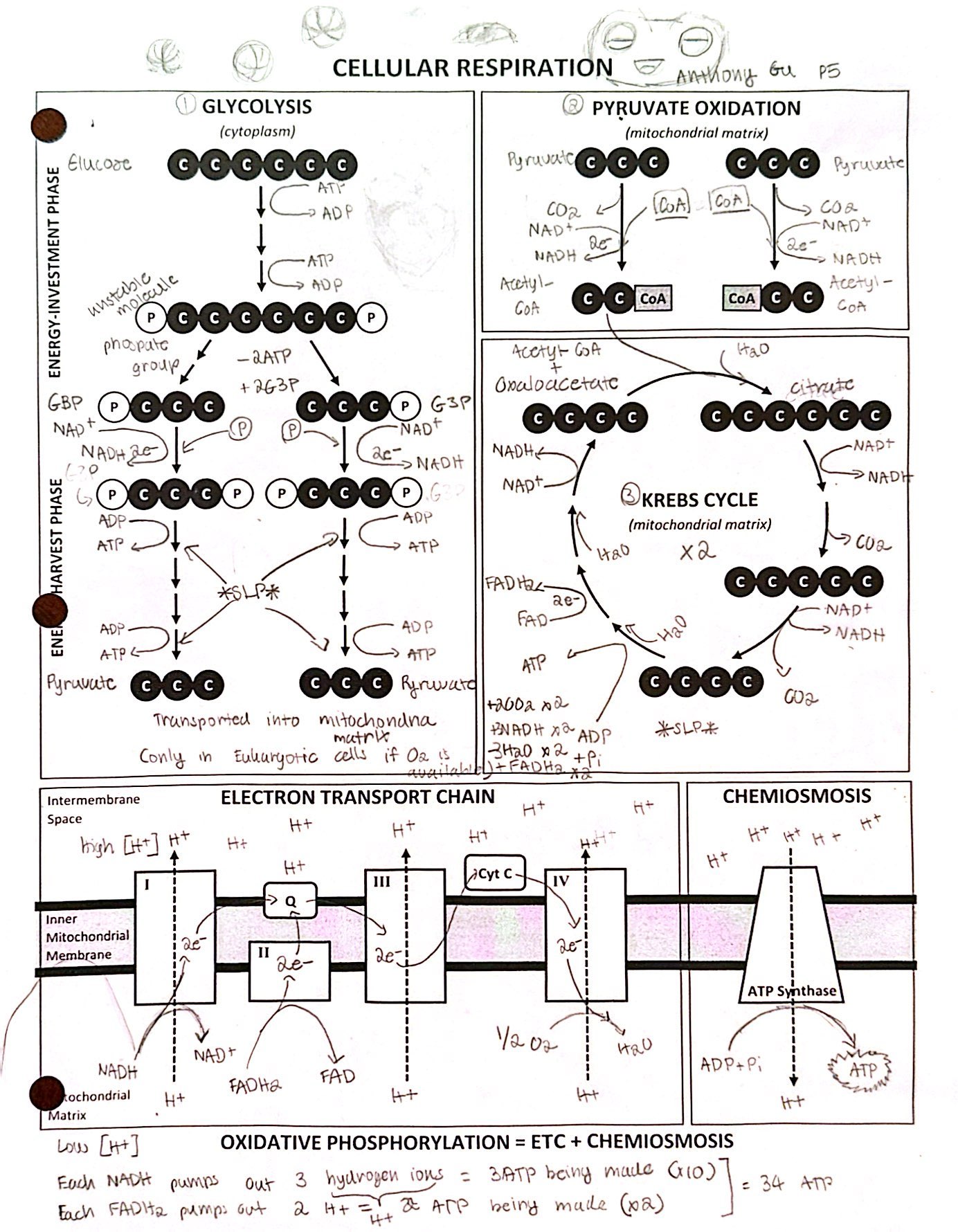
Glycolysis
The first stage of cellular respiration, occurring in the cytosol, that splits one glucose (6C) into two pyruvate (3C) molecules. It yields a net of 2 ATP, 2 NADH, and is anaerobic.
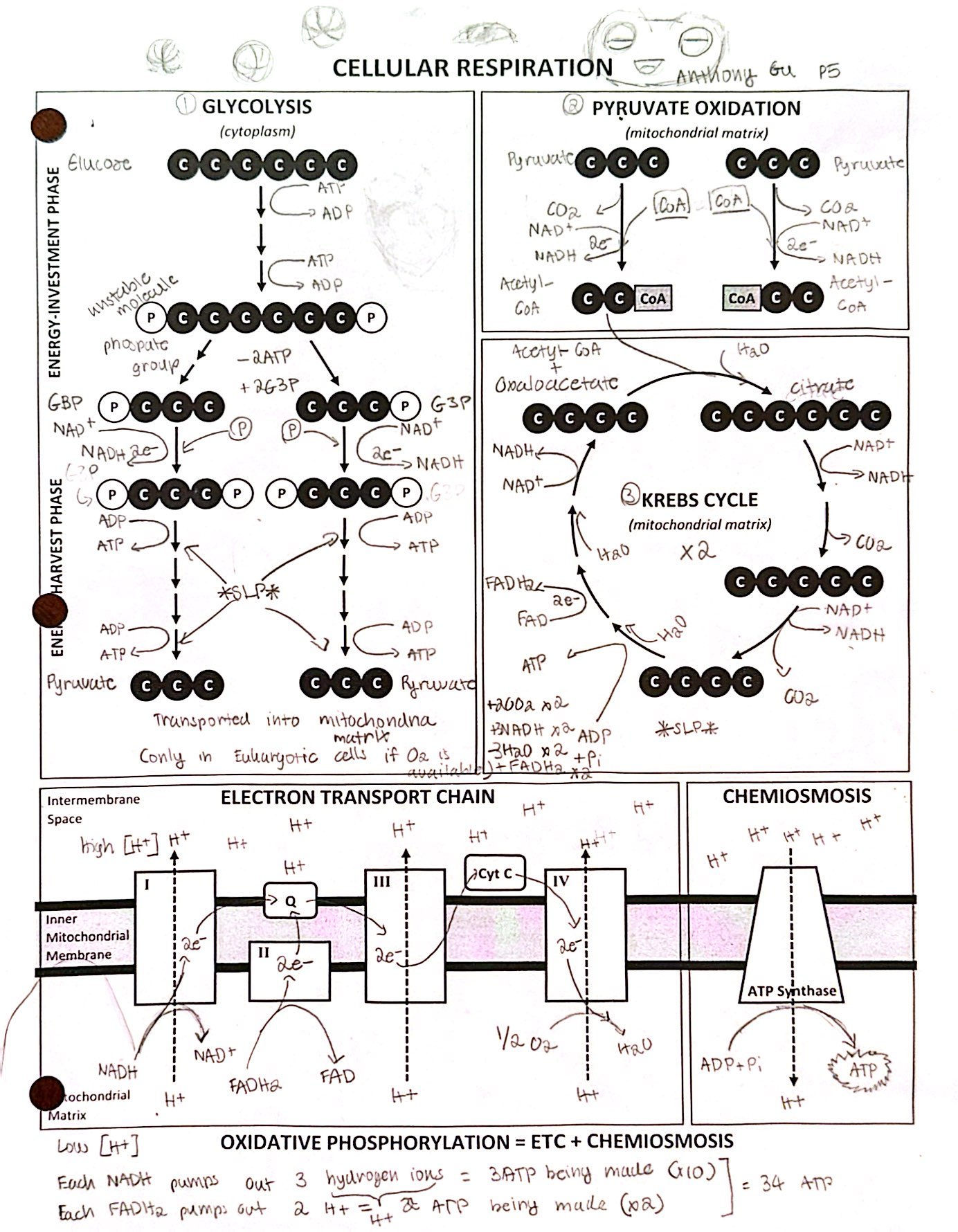
Energy Investment Phase
The first phase of glycolysis where the cell uses 2 ATP to phosphorylate glucose, leading to its destabilization and splitting into two G3P molecules.
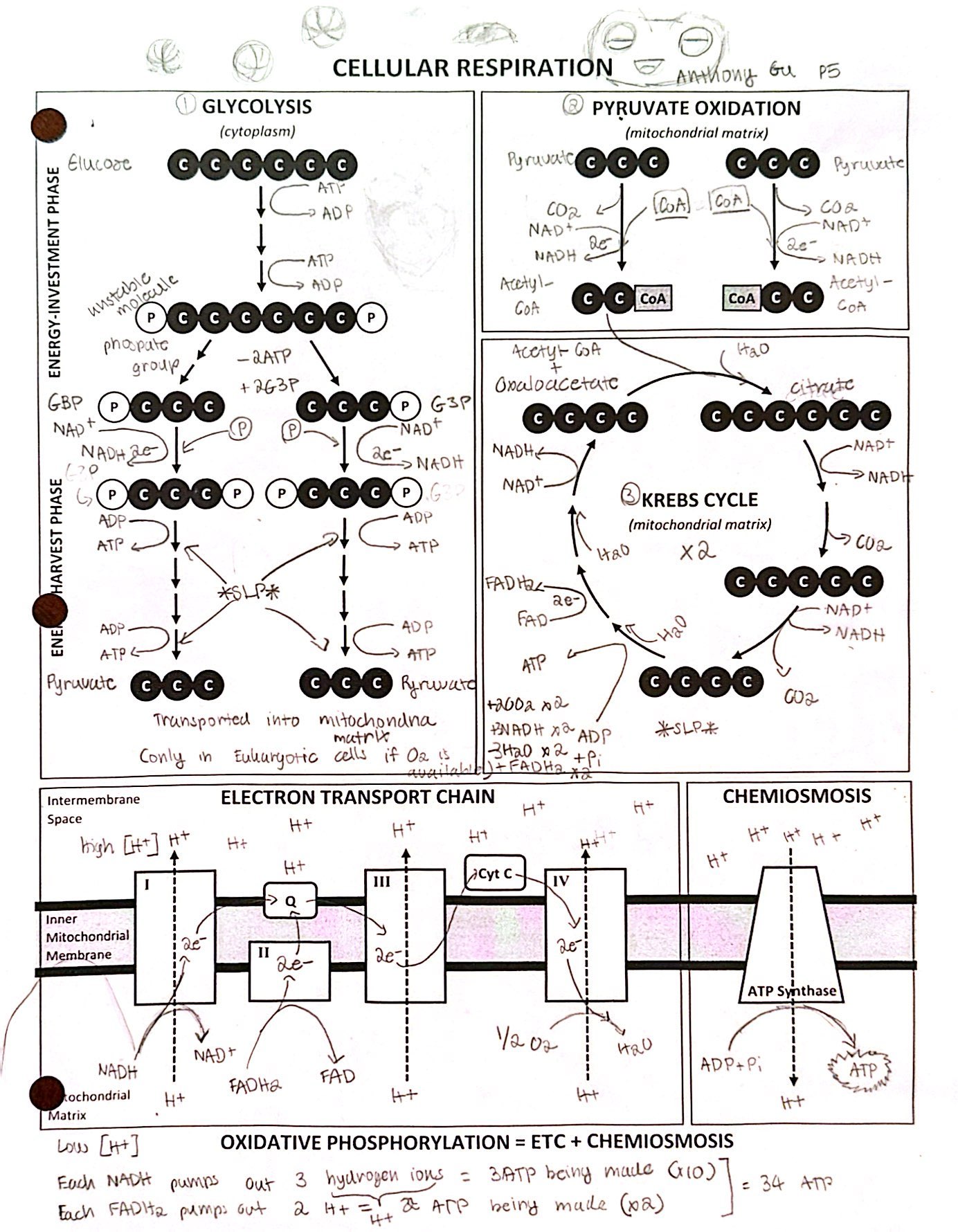
Energy Harvesting Phase
The second phase of glycolysis where G3P is oxidized to pyruvate, producing 4 ATP (net 2 ATP) and 2 NADH.
Substrate-Level Phosphorylation
The enzyme-catalyzed direct transfer of a phosphate group from a substrate molecule to ADP, forming ATP. Occurs in glycolysis and the Krebs cycle.
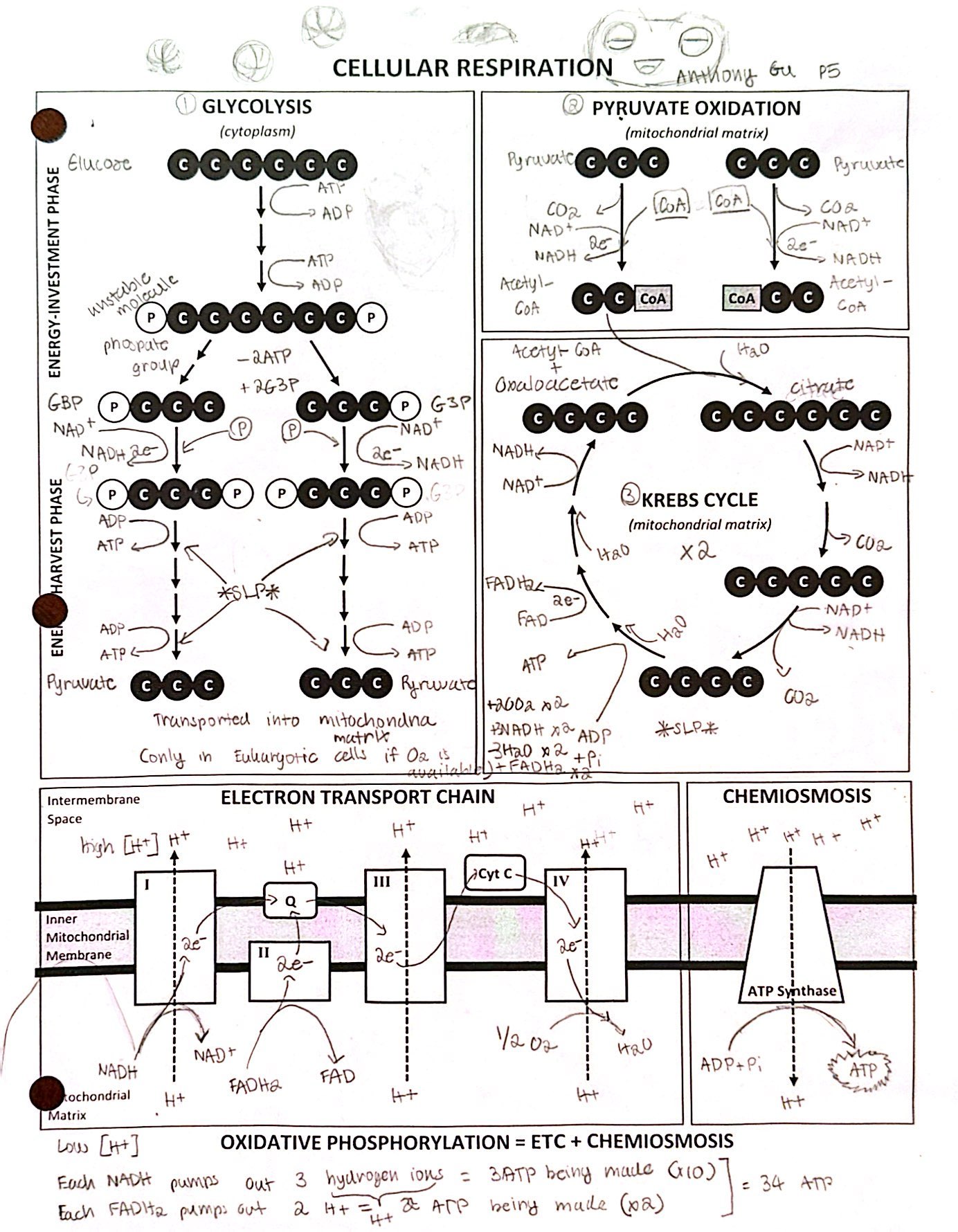
Pyruvate Oxidation
The link step occurring in the mitochondrial matrix where each pyruvate is oxidized to Acetyl CoA, producing 1 CO2, 1 NADH, and 1 Acetyl CoA per pyruvate.
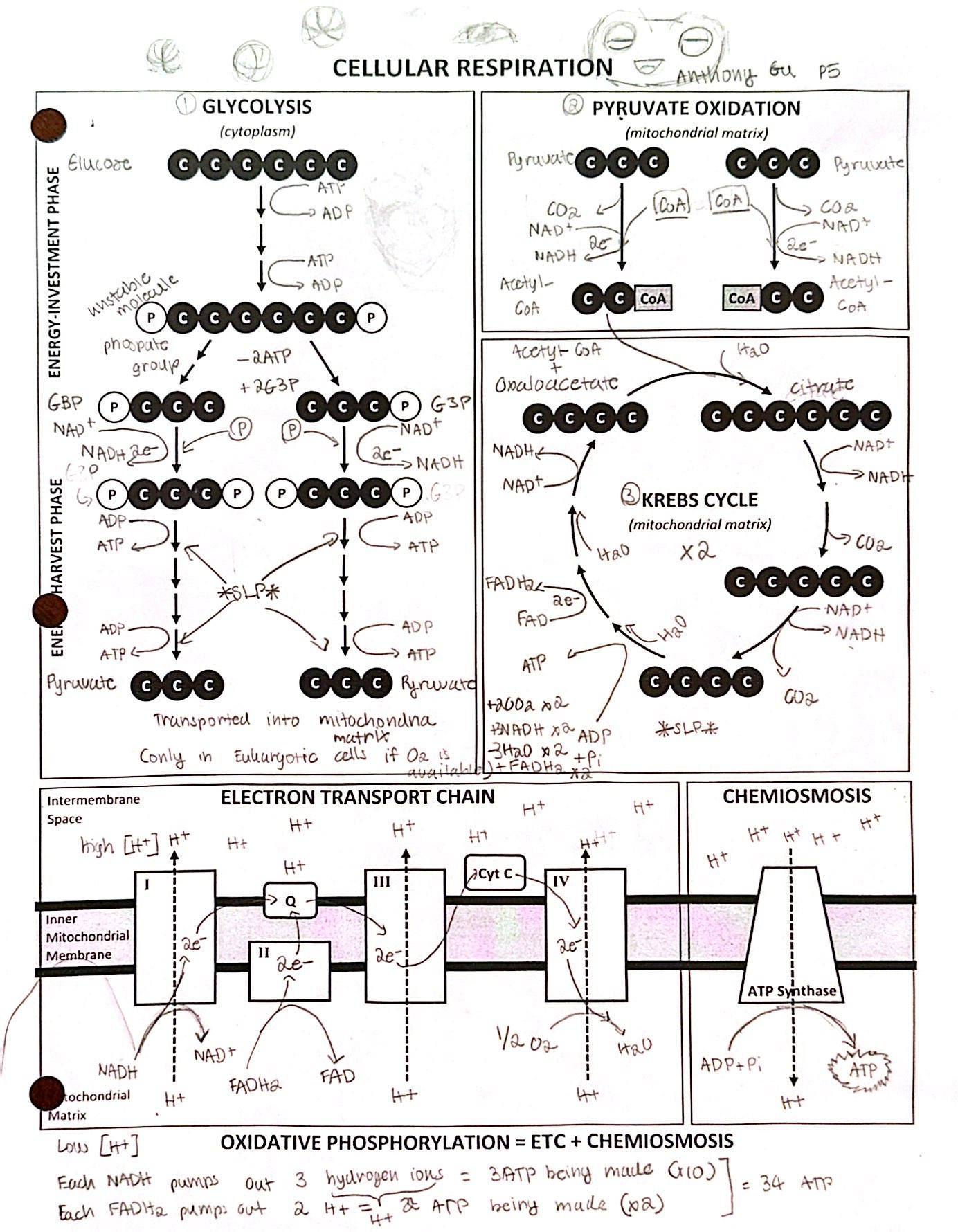
Krebs Cycle (Citric Acid Cycle)
A series of 8 reactions in the mitochondrial matrix that completes the oxidation of glucose by breaking down Acetyl CoA to CO2. Per glucose, it yields 2 ATP, 6 NADH, 2 FADH2, and 4 CO2.
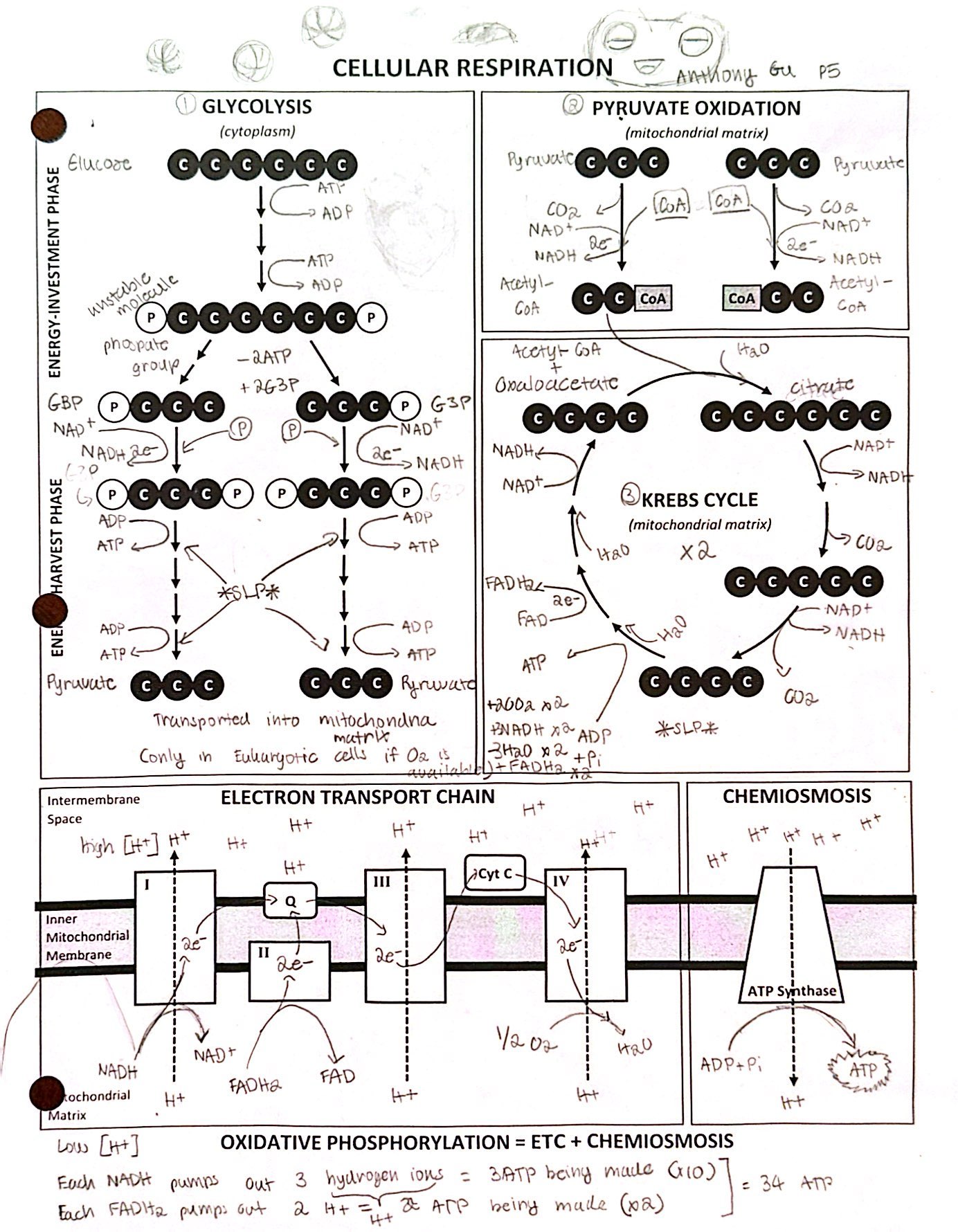
Oxidative Phosphorylation
The process that generates most of the ATP during cellular respiration; occurs on the inner mitochondrial membrane and consists of the electron transport chain and chemiosmosis.

Electron Transport Chain (ETC)
A series of protein complexes embedded in the inner mitochondrial membrane (or plasma membrane in prokaryotes) that accept electrons from NADH and FADH2. The energy released from electron transfer is used to pump H+ into the intermembrane space.

Chemiosmosis
The process of using energy stored in the form of a proton (H+) gradient across a membrane to drive cellular work, such as the phosphorylation of ADP to ATP by ATP synthase.
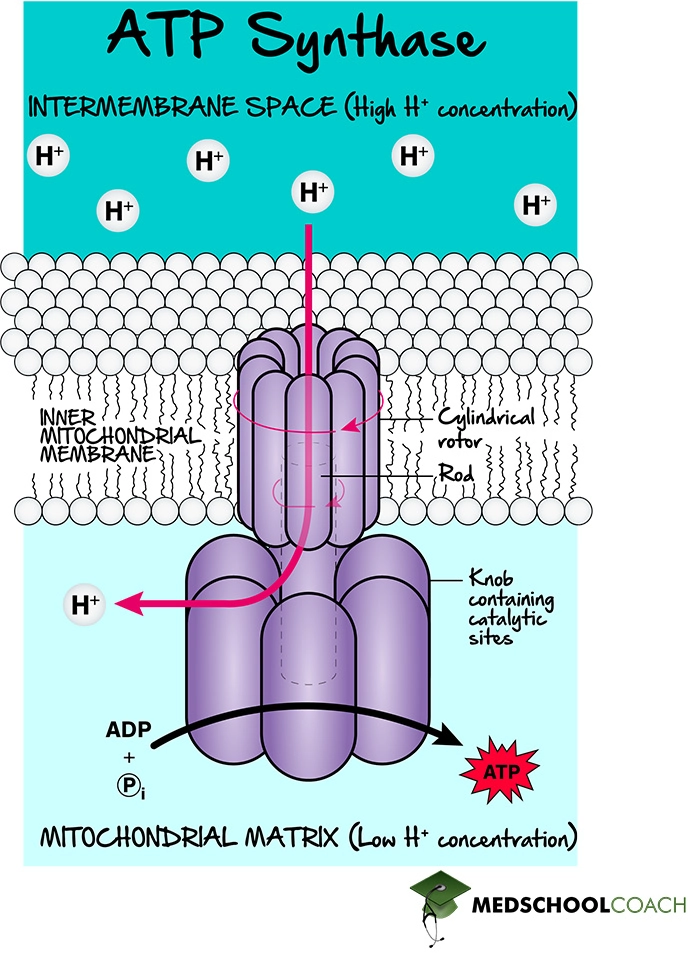
Proton-Motive Force
The potential energy stored in the form of an electrochemical proton gradient across a membrane, generated by the electron transport chain.
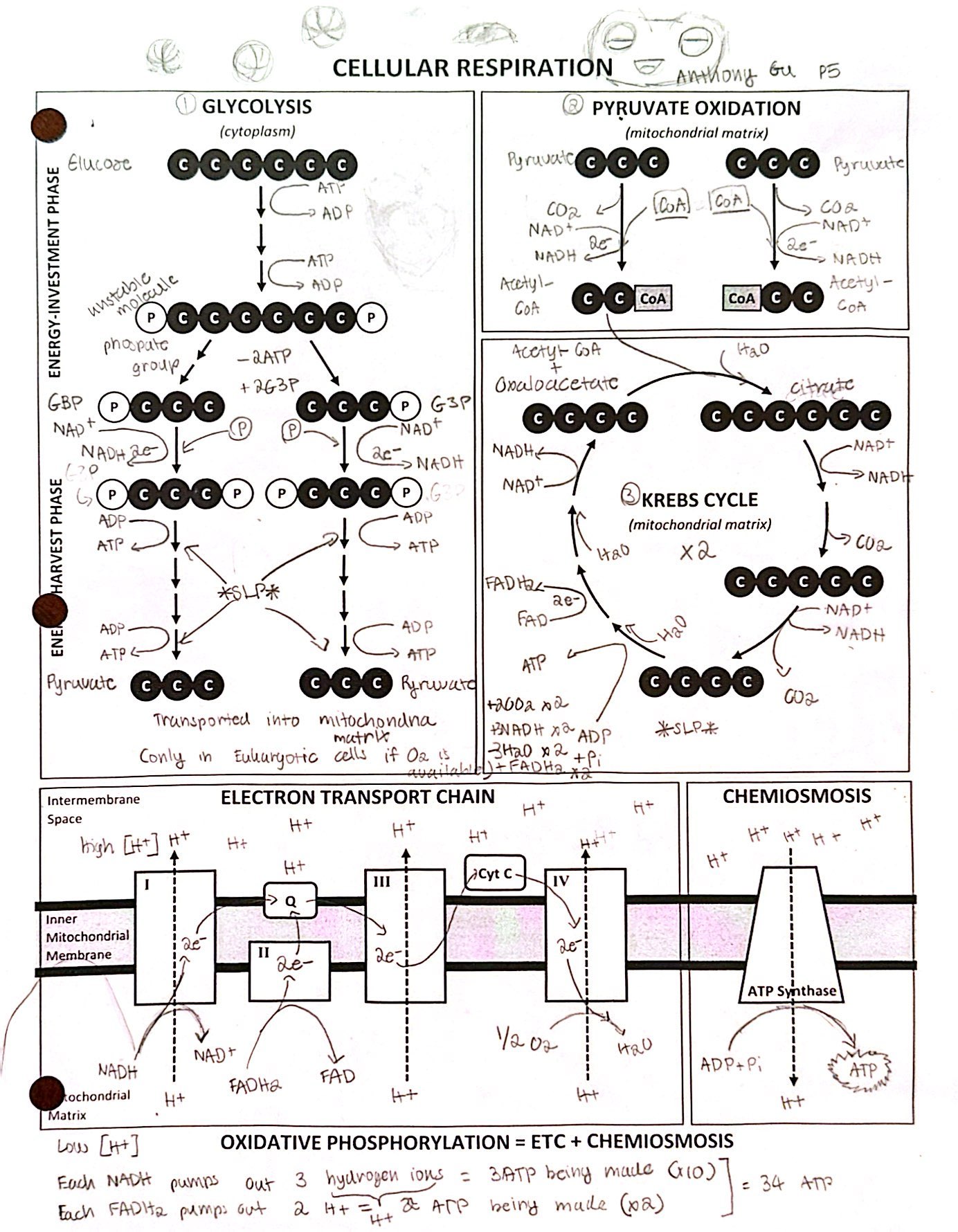
ATP Synthase
A large protein complex embedded in the inner mitochondrial membrane, thylakoid membrane, or bacterial plasma membrane that uses the exergonic flow of H+ down its gradient to power ATP synthesis.

Intermembrane Space
The region between the inner and outer membranes of the mitochondria; the site of high H+ concentration during electron transport.

Mitochondrial Matrix
The compartment enclosed by the inner mitochondrial membrane; the site of pyruvate oxidation and the Krebs cycle; the site of low H+ concentration during electron transport.
Final Electron Acceptor
The molecule that accepts electrons at the end of an electron transport chain. In aerobic respiration, it is oxygen (forming H2O). In anaerobic respiration, it is an inorganic molecule like sulfate or nitrate.
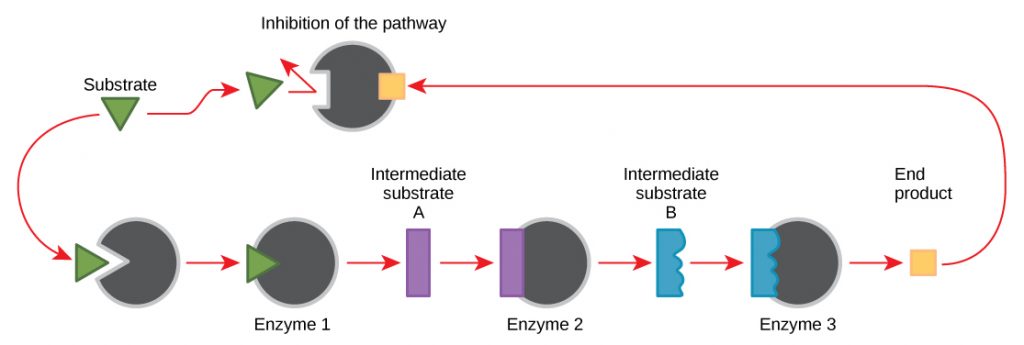
Feedback Inhibition
A metabolic control mechanism where a pathway is switched off by the inhibitory binding of its end product (e.g., ATP) to an enzyme that acts early in the pathway.
Decoupling (Oxidative Phosphorylation)
When protons are allowed to diffuse back into the mitochondrial matrix without passing through ATP synthase (e.g., via uncoupling proteins), generating heat instead of ATP.
Uncoupling Proteins
Proteins embedded in the inner mitochondrial membrane that allow protons to leak back into the matrix, dissipating the proton gradient as heat (non-shivering thermogenesis).
Facultative Anaerobe
An organism (e.g., some bacteria and yeast) that can survive using either aerobic respiration (when oxygen is present) or switch to fermentation/anaerobic respiration (when oxygen is absent).
Obligate Anaerobe
An organism that is poisoned by oxygen and can live and grow only by performing fermentation or anaerobic respiration in the absence of oxygen.
Fermentation
A partial degradation of sugars or other organic fuel that occurs without the use of oxygen, coupling glycolysis with reactions to regenerate NAD+ from NADH. It only produces 2 ATP per glucose.
Alcohol Fermentation
Glycolysis followed by the reduction of pyruvate to ethanol, regenerating NAD+ and releasing CO2. Performed by yeast and some bacteria.
Lactic Acid Fermentation
Glycolysis followed by the reduction of pyruvate to lactate, regenerating NAD+. Performed by some bacteria, fungi, and human muscle cells.
Anaerobic Respiration
A type of cellular respiration used by some prokaryotes where an electron transport chain is used with a final electron acceptor other than oxygen (e.g., sulfate, nitrate); produces more ATP than fermentation.
Versatility of Catabolism
The concept that catabolic pathways can break down a wide range of organic molecules—not just glucose—and funnel their intermediates into cellular respiration (e.g., proteins to amino acids, fats to glycerol & fatty acids).
Evolutionary Significance of Glycolysis
Glycolysis is the most widespread metabolic pathway, found in all three domains of life, because it occurs in the cytosol without organelles or oxygen, indicating it evolved in ancient prokaryotes.
Photosynthesis
The process used by photoautotrophs that converts light energy into chemical energy, stored in the bonds of sugar. The overall equation is 6CO2 + 6H2O + Light Energy → C6H12O6 + 6O2.
Autotroph
An organism that obtains organic food molecules without eating other organisms; it uses energy from the sun (photoautotroph) or inorganic chemicals (chemoautotroph) to make organic molecules from CO2.
Photoautotroph
An organism that harnesses light energy to drive the synthesis of organic compounds from carbon dioxide (e.g., plants, algae, cyanobacteria).
Chemoautotroph
An organism that uses energy from specific inorganic chemicals (e.g., H2S, S, Fe, NH3) to produce organic molecules from CO2; typically bacteria and archaea in extreme environments.
Heterotroph
An organism that obtains organic food molecules by consuming other organisms or their by-products.
Phytoplankton
Photosynthesizing, microscopic, free-floating organisms found in aquatic ecosystems (e.g., cyanobacteria, microscopic algae); they are major producers and are estimated to produce 50-85% of the world's oxygen.
Chloroplast
The organelle in plants and photosynthetic eukaryotes where photosynthesis takes place.
Stomata
Microscopic pores on the surface of leaves and stems through which CO2 enters and O2 exits the plant; also the site of water loss via transpiration.
Mesophyll
The green tissue in the interior of a leaf where most chloroplasts are located.
Chlorophyll
The green pigment located in the thylakoid membranes of chloroplasts; it absorbs light energy to drive the reactions of photosynthesis.
Thylakoid
A flattened, membranous sac inside a chloroplast that contains chlorophyll; the site of the light-dependent reactions.
Grana (singular: Granum)
Stacks of thylakoids within the chloroplast.
Stroma
The dense fluid surrounding the thylakoids inside the chloroplast; the site of the Calvin cycle (light-independent reactions).
Thylakoid Lumen
The fluid-filled space inside a thylakoid.
Light Reactions (Light-Dependent Reactions)
The first phase of photosynthesis that occurs in the thylakoids; they require light to split water (photolysis), release O2, produce ATP, and form NADPH.
Calvin Cycle (Light-Independent Reactions)
The second phase of photosynthesis that occurs in the stroma; it uses ATP and NADPH from the light reactions to synthesize sugar (G3P) from CO2.
Photolysis
The splitting of a water molecule using light energy; occurs in Photosystem II, providing electrons to replace those lost by P680, and releasing O2 and H+ ions.
Electromagnetic Energy
Energy that travels in rhythmic waves, such as light.
Photon
A discrete particle, or "packet," of light energy.
Pigment
A substance that absorbs specific wavelengths of visible light while reflecting others.
Absorption Spectrum
A graph that shows a pigment's light absorption across the various wavelengths of the visible spectrum.
Chlorophyll a
The primary photosynthetic pigment that participates directly in the light reactions; it absorbs best in the red and blue-violet wavelengths.
Chlorophyll b
An accessory photosynthetic pigment that absorbs light energy and transfers it to chlorophyll a; it broadens the range of light used for photosynthesis.
Carotenoids
Accessory pigments (yellow, orange, brown) that absorb light energy and transfer it to chlorophyll a; they also absorb and dissipate excessive light energy that might damage chlorophyll.
Photosystem
A protein complex embedded in the thylakoid membrane, composed of a reaction-center complex surrounded by light-harvesting complexes; it uses light energy to excite electrons.
P680
The pair of special chlorophyll a molecules in the reaction center of Photosystem II (PS II); it is named for its absorption peak at 680 nm.
P700
The pair of special chlorophyll a molecules in the reaction center of Photosystem I (PS I); it is named for its absorption peak at 700 nm.
Primary Electron Acceptor
A molecule in the reaction center of a photosystem that accepts the high-energy electrons excited by light from the chlorophyll a molecules (P680 or P700).
Electron Transport Chain (ETC) in Photosynthesis
A series of electron carrier proteins in the thylakoid membrane that shuttle electrons from Photosystem II to Photosystem I; the energy released is used to pump H+ into the thylakoid lumen.
NADP+ / NADPH
NADP+ is an electron carrier molecule. When it accepts two high-energy electrons and a H+ ion, it is reduced to NADPH. NADPH carries electrons (as reducing power) to the Calvin cycle.
NADP+ Reductase
The enzyme complex that catalyzes the reduction of NADP+ to NADPH using high-energy electrons from Photosystem I.
Chemiosmosis (in Chloroplasts)
The process by which energy stored in a proton gradient across the thylakoid membrane is used to drive ATP synthesis as H+ ions diffuse back into the stroma through ATP synthase.
ATP Synthase (in Chloroplasts)
A protein complex embedded in the thylakoid membrane that uses the kinetic energy of H+ ions flowing down their gradient to catalyze the synthesis of ATP from ADP and Pi.
Proton (H+) Gradient (in Chloroplasts)
A difference in hydrogen ion concentration across the thylakoid membrane; a high H+ concentration in the thylakoid lumen and a low concentration in the stroma creates potential energy for ATP synthesis.
Calvin Cycle
The cycle of reactions in the stroma of chloroplasts where carbon fixation occurs, producing the sugar G3P using ATP and NADPH from the light reactions.
Carbon Fixation
The initial incorporation of carbon from atmospheric CO2 into an organic molecule (3-PGA) by the enzyme rubisco.
Rubisco (Ribulose bisphosphate carboxylase/oxygenase)
The enzyme that catalyzes the first step of the Calvin cycle by adding CO2 to RuBP; it is the most abundant enzyme on Earth.
Ribulose Bisphosphate (RuBP)
A 5-carbon sugar that is the starting and ending molecule of the Calvin cycle; it is the molecule to which CO2 is fixed by rubisco.
3-Phosphoglycerate (3-PGA)
A 3-carbon molecule formed when the unstable 6-carbon intermediate created from RuBP and CO2 immediately breaks down.
Glyceraldehyde-3-Phosphate (G3P)
A 3-carbon sugar that is the direct carbohydrate product of the Calvin cycle. For every 3 cycles, one G3P exits. Its fate is to be used by the plant to build glucose, fructose, starch, cellulose, amino acids, and lipids.